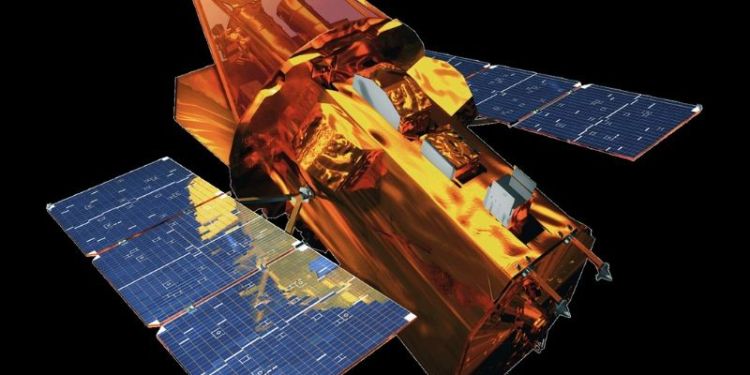Ravenous black hole takes bites out of star

A ravenous black hole in a galaxy close to ours is taking bites out of a star like the Sun every time it orbits, new research has revealed.
The star is losing the equivalent to three Earths every time it passes close to the supermassive black hole, fresh data from the Neil Gehrels Swift Observatory has shown.
The discovery by astronomers at the universities of Leeds and Leicester, published today in Nature Astronomy, provides a ‘missing link’ in our knowledge of black holes disrupting orbiting stars, suggesting a whole menagerie of stars in the process of being consumed that still lie undiscovered.
Dr Chris Nixon, Associate Professor in Theoretical Astrophysics at the University of Leeds’ School of Physics and Astronomy, said the phenomenon was a “more extreme” version of the way the gravitational pull of the Moon affects the Earth’s oceans and controls the tides.
Dr Nixon, who worked on the research with former colleagues at the University of Leicester, added: “This was a quiet galaxy with no detectable activity from the central supermassive black hole. Then suddenly we see bursts of X-rays. This tells us that a star is orbiting too close to the black hole and having its outer layers pulled off, and this matter is then pulled in by the black hole. The repeating nature of the outbursts tells us that the star is just about managing to hold itself together, for now.”
The astronomers were alerted to the star by a bright X-ray flash that seemed to come from the centre of the nearby galaxy 2MASX J02301709+2836050, around 500 million light-years away from the Milky Way. Named Swift J0230, it was spotted the moment the signal arrived using a new tool developed by the scientists for NASA’s Neil Gehrels Swift Observatory. They rapidly scheduled further Swift observations of it and found that instead of decaying as expected, it would shine brightly for 7-10 days and then abruptly switch off, repeating this process roughly every 25 days.
Incredibly rare
Dr Nixon, whose research is supported by the UK Science and Technology Facilities Council and The Leverhulme Trust, added: “In any individual galaxy such extreme tidal encounters between stars and black holes are incredibly rare, with typically one every 100,000 years or so. But there are so many galaxies in the Universe that every few seconds a star is being pulled apart by a supermassive black hole somewhere out there. It’s thanks to some amazing observatories that we have such a good understanding of what is going on in distant galaxies.”
Similar behaviour has been observed in what are termed quasi-periodic eruptions and periodic nuclear transients, where a star has material ripped away by a black hole as its orbit takes it close by, but they differ in how often they erupt, and in whether it is in X-rays or optical light that the explosion is predominant. The regularity of Swift J0230’s emissions fell between the two, suggesting that it forms the ‘missing link’ between the two types of outburst.
The scientists concluded that the Swift J0230 outburst represents a star of a similar size to our own sun, in an elliptical orbit around a low-mass black hole at the centre of its galaxy. As the star’s orbit takes it too close to the black hole, material equivalent to the mass of three Earths is wrenched from the atmosphere of the star and heated up as it falls into the black hole. The intense heat, around 2 million degrees Celsius, releases a huge amount of X-rays which are picked up by the Swift satellite.
New discovery
Lead author Dr Phil Evans of the University of Leicester School of Physics and Astronomy, said: “This is the first time we've seen a star like our Sun being repeatedly shredded and consumed by a low mass black hole.
“So-called ‘repeated, partial tidal disruption events’ are themselves quite a new discovery and seem to fall into two types: those that outburst every few hours, and those that outburst every year or so. This new system falls right into the gap between these, and when you run the numbers, you find the types of objects involved fall nicely into place too.”
The scientists estimate that the black hole is around 100,000 to a million times the mass of our sun, which is quite small for the supermassive black holes usually found at the centre of galaxies. The black hole at the centre of our own galaxy is thought to be 4 million solar masses, while most are in the region of 100 million solar masses.
It is the first discovery to be made using the new transient detector for the Swift satellite, developed by the University of Leicester team and running on their computers. When an extreme event takes place, causing an X-ray burst in a region of the sky where there were previously no X-rays, astronomers call it an astronomical X-ray transient. Despite the extreme events they herald, these events are not easy to find and so this new tool was developed to look for new types of transients in real time.
Dr Evans added: “This type of object was essentially undetectable until we built this new facility, and soon after it found this completely new, never-before-seen event. Swift is nearly 20 years old and it's suddenly finding brand new events that we never knew existed. I think it shows that every single time you find a new way of looking at space, you learn something new and find there's something out there you didn't know about before.”
Dr Caroline Harper, Head of Space Science at the UK Space Agency, which funded the UK Swift team, said: “This is yet another exciting discovery from the world-leading Swift mission - a low mass black hole taking ‘bites’ from a Sun-like star whenever it orbits close enough.
“The UK Space Agency has been working in partnership with NASA on this mission for many years; the UK led on the development of hardware for two of the key science instruments and we provided funding for the Swift Science Data Centre, which we continue to support. We look forward to even more insights from Swift about gamma ray bursts throughout the cosmos, and the massive events that cause them, in the future.”
Further Information
- NASA has produced a video explaining exactly what the team of scientists discovered
- ‘Recurring X-ray eruptions from a galaxy nucleus: a candidate repeating stellar disruption around a supermassive black hole’ was published today (September 7) in Nature Astronomy
- Picture credit: NASA, Sonoma State University, Aurora Simonnet
- For media enquiries, please contact Matt Gardner, the Faculty Communications Manager for Engineering and Physical Sciences, via M.D.Gardner@leeds.ac.uk.




